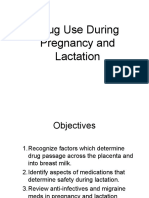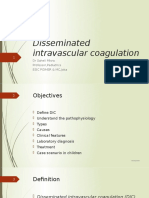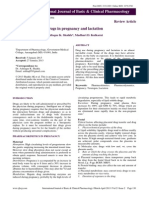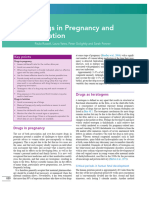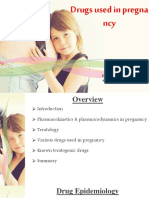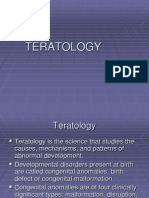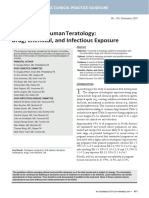Professional Documents
Culture Documents
Teratogenic Effect of Different Drugs at Different Stages in Pregnancy
0 ratings0% found this document useful (0 votes)
179 views4 pagesBecause of the potential for teratogenic
medication effects on the foetus, treating common
ailments during pregnancy is challenging. The first eight
weeks of human development are referred to as the
embryogenesis period, sometimes known as the
organogenesis period. Such a deficiency is caused by a
teratogenic agent, which are compounds that could harm
the human embryo or foetus physically or functionally.
Original Title
Teratogenic Effect of Different Drugs at Different Stages in Pregnancy
Copyright
© © All Rights Reserved
Available Formats
PDF, TXT or read online from Scribd
Share this document
Did you find this document useful?
Is this content inappropriate?
Report this DocumentBecause of the potential for teratogenic
medication effects on the foetus, treating common
ailments during pregnancy is challenging. The first eight
weeks of human development are referred to as the
embryogenesis period, sometimes known as the
organogenesis period. Such a deficiency is caused by a
teratogenic agent, which are compounds that could harm
the human embryo or foetus physically or functionally.
Copyright:
© All Rights Reserved
Available Formats
Download as PDF, TXT or read online from Scribd
0 ratings0% found this document useful (0 votes)
179 views4 pagesTeratogenic Effect of Different Drugs at Different Stages in Pregnancy
Because of the potential for teratogenic
medication effects on the foetus, treating common
ailments during pregnancy is challenging. The first eight
weeks of human development are referred to as the
embryogenesis period, sometimes known as the
organogenesis period. Such a deficiency is caused by a
teratogenic agent, which are compounds that could harm
the human embryo or foetus physically or functionally.
Copyright:
© All Rights Reserved
Available Formats
Download as PDF, TXT or read online from Scribd
You are on page 1of 4
Volume 8, Issue 6, June – 2023 International Journal of Innovative Science and Research Technology
ISSN No:-2456-2165
Teratogenic Effect of Different Drugs at Different
Stages in Pregnancy
Ambeya khatoon, Rohit Kumar Trivedi (Guide)
College of Pharmacy (Shivalik Campus), Dehradun
Abstract:- Because of the potential for teratogenic II. STAGES OF PREGNANCY
medication effects on the foetus, treating common
ailments during pregnancy is challenging. The first eight First trimester: - 1 to 3 Months (week1 through 12)
weeks of human development are referred to as the The first trimester lasts 12 weeks and starts at
embryogenesis period, sometimes known as the fertilisation. Pregnancy usually goes like way for the first
organogenesis period. Such a deficiency is caused by a three months. During this trimester, the fertilised egg will
teratogenic agent, which are compounds that could harm grow from a small group of cells into a foetus that is
the human embryo or foetus physically or functionally. beginning to exhibit human characteristics [3]. Although the
An acknowledgment of the tragedies caused by the first trimester is delightful, the majority of people also go
thalidomide epidemic in the 1970s and the rubella through this time with painful symptoms including fatigue
epidemic in the early 1960s in the field of teratology. and morning sickness [5].
Chloramphenicol, Warfarin, Valproate, and
Thalidomide are a few of the medications that might Second trimester: - 4 to 7 Months (weeks13 through 28)
cause abnormalities such microcephaly, hydrocephalus, The second trimester of pregnancy is usually viewed as
spina bifida, and a number of other syndromes. Many of the best part. By this time, any morning sickness should
these substances can enter human tissue and a have passed, along with any discomfort from the early
developing foetus, which can have detrimental effects on stages of pregnancy. You may also start to feel movement
the human reproductive health. Numerous biological when the foetus flips and spins inside your uterus. [1].
and physical elements, like as radiation and infection,
contribute to teratogenic effects. Third trimester: - 8 to 10 Months (weeks29 through 40)
The last stage of your pregnancy is this. Avoid the
Keywords:- Teratogenic, Teratogenicity, Birth Defects, temptation to start counting down the days until your due
Pregnancy, Early Pregnancy, Miscarriage, Stillbirth, date in the hopes that it will arrive early by resisting the
Preterm Birth, Congenital abnormalities. urge. With each week of this final period of development,
the foetus prepares for birth. During the third trimester, the
I. INRODUCTION foetus gains weight quickly and gains body fat that will be
advantageous after birth [6].
Due to the risk of teratogenic consequences from the
drug and physiologic changes in the mother as a result of the III. RISK OF TERATOGENICITY OF DRUGS
pregnancy, drug therapy presents a specific concern during USED IN PREGNANCY
pregnancy [1,7]. When a sperm enters an egg, pregnancy
happens. This process, known as fertilisation, often takes Antiepileptic drugs:
place in the fallopian tube of the female. The fertilised egg AEDs have been suspected as having teratogenic
starts to divide right away, creating a huge mass of cells. potential since the 1960s. Most WWE cannot afford to stop
The fertilised egg implants into the uterine wall between 5-7 using AEDs because seizures pose a risk of harm or perhaps
days after ovulation and begins to create the placenta [2]. death [10]. Anti-epileptic medications increase the
The first eight weeks of pregnancy are primarily when likelihood of conceiving a kid with congenital abnormalities
medications have an impact on how the human embryo more than the general population [3]. AED use during the
develops. The blastocyst is free to move around in the uterus first trimester of pregnancy may increase the likelihood that
for the first week and relies on uterine secretion for children delivered to WWE (Well Women Exam) women
sustenance. At this point, it is unknown if exogenous factors will require medical countermeasures [10].
like medications can result in congenital abnormalities, but
they can cause the embryo's death [3]. A, B, C, D, or X risk Analgesics and Anti-inflammatory Drugs:
categories were created by the FDA to indicate a drug's Acetaminophen and Propoxyphene are reasonable
potential to cause birth defects if used during pregnancy in choice when symptomatic relief of pain is required.
1979 [5]. The formation of deformities in the foetus is Acetylsalicylic acid has probably more widely used in
referred to as teratogenic. A teratogenic drug causes such a pregnancy but high doses may cause intrauterine growth
defect. The term "teratogen" is typically used to describe retardation. Propoxyphene has not been associated with
chemicals that impede the normal anatomical development teratogenic effects, but codeine has been related to
of an embryo [4]. congenital abnormalities in the respiratory system [3].
IJISRT23JUN1529 www.ijisrt.com 2055
Volume 8, Issue 6, June – 2023 International Journal of Innovative Science and Research Technology
ISSN No:-2456-2165
Antidepressants and Anxiolytics Drugs:
Clinical experience has shown that pregnant women IV. HOW DO DRUGS CROSS THE PLACENTA
exposed to antidepressants experience greater spontaneous
abortions and stillbirths. Poor Neonatal Adaptation (PNA) is Most drugs can cross the placenta by passive diffusion
more common when pregnant women receive treatment in Placental membrane is semi-permeable
the third trimester [11]. Diazepam (Valium) use during Movement of drugs through the placenta is limited by a
pregnancy has been linked in certain studies to birth single layer of trophoblast [31].
malformations include cleft lip, heart issues, and pyloric
stenosis [3]. Due to the possibility of congenital V. TERATOGENESIS AND FDA
malformations, lithium should be avoided during pregnancy CLASSIFICATION DRUG
[3].
Teratogenesis
Ciprofloxacin and Levofloxacin: Congenital abnormalities of the foetus occur. These are
Levofloxacin and Cipro are examples of other compounds that, when exposed to an embryo or foetus, can
antibiotics. These medications may impair the baby's poison them and result in lifelong birth abnormalities.
skeletal and muscular development as well as the mother's (Mistakes in functionality or structure) [31].
joints and possibly even cause nerve damage [21].
Table 1 FDA Classification Drugs
Category Characteristics Examples
The foetus in the first trimester of pregnancy is not at risk, according
A Folic acid Thyroxine
to adequate and controlled research conducted in women.
There are no controlled trials in pregnant women, despite animal
B Paracetamol Erythromycin
reproductive research failing to show a risk to the foetus
Only if the potential benefits outweigh the potential risks to the foetus
should drugs be given, regardless of whether studies in animals have
C Morphine
demonstrated a harmful effect on the foetus (teratogenic, embryocidal,
or other).
Based on data from studies on adverse reactions, there is strong
D evidence that there is a danger to the human foetus, although the Antiepileptics
benefits of using the medicine while pregnant may outweigh the risks.
Proven foetal abnormalities in animal and human studies. Drugs
X should only be administered if the possible advantages outweigh the Thalidomide Sedative
potential hazards to the foetus [2].
VI. TERATOGENESIS OF DRUGS AT STAGES
Table 2 First Trimester
FIRST TRIMESTER
Phocomelia: - Absence of organ, one or more limbs and is denoted a terminal
Thalidomide transverse defect.
Shortened or absent long bones of the limbs
Foetal Hydantoin Syndrome
Phenytoin Nail and digital hypoplasia
Oral cleft (cleft lip and palate)
Foetal Alcohol Syndrome
CVS abnormalities
Alcohol
CNS abnormalities
Permanent teeth staining
Tetracycline Discoloration and hypoplasia
Caries and pigmentation of permanent teeth
Corticosteroids Cleft lip and palate
IJISRT23JUN1529 www.ijisrt.com 2056
Volume 8, Issue 6, June – 2023 International Journal of Innovative Science and Research Technology
ISSN No:-2456-2165
Hypoplasia of nasal bridge
Warfarin CNS malformation
Anticoagulant
Table 3 The Second and Third Trimester
THE SECOND AND THIRD TRIMESTER
Chloramphenicol Gray baby syndrome
Bradycardia
Propranolol Neonatal hypoglycaemia
Poor uterine blood flow
Prostaglandin synthesis inhibitors
NSAIDs
Increase risk for postpartum haemorrhage
ACE inhibitor Renal damage
Risk for neonatal hypothyroidism and goitres (Methimazole, Carbimazole, Iodide and
Antithyroids Propylthiouracil)
Chloramphenicol Gray baby syndrome
VII. CONCLUSION [7]. https://my.clevelandclinic.org/health/articles/7247-
fetal-development-stages-of-growth
The study's analysis of this literature demonstrates that [8]. Evans JM, Libby G, Crombie IK, Flynn RW, and
worries about medication use during pregnancy are not Irvine. Prenatal medication prescribed in primary care:
limited to the possibility of delivering a kid with a a record-linkage study in Tayside, Scotland. safe for
congenital birth defect. Despite the fact that pregnant drugs. PMID: 20553060. 2010 Jul 1;33(7):593-604.
women exaggerate the teratogenic risk of medicine usage, doi: 10.2165/11532330-000000000-00000.
the majority of the drugs were thought to carry relatively [9]. Ridley E., Alván G., Prame B., Kihlström I.,
modest risks and substantial rewards. This can be considered Sannerstedt R., Lindborg P., Danielson BR. Prescriber
by medical professionals when counselling expectant ladies. education and risk classification for medications during
From the literature, we isolated six key teratogenic pathways pregnancy. safe for drugs. doi: 10.2165/00002018-
related to the use of medical drugs. Numerous other 199614020-00001. PMID: 8852521. 1996
prescription and over-the-counter medications may also Feb;14(2):69-77.
promote tumorigenesis through these mechanisms, in [10]. Meador KJ and Gedzelman E. Anti-epileptic
addition to the fact that nearly all medicinal pharmaceuticals medications for pregnant women with epilepsy. The
recognised by Schwarz et al. (2007) as U.S. FDA class X are Advance. safe for drugs. 2012 Apr;3(2):71-87. doi:
associated to at least one of these processes. some 10.1177/2042098611433192; PMCID: PMC4110845;
prescription drugs PMID: 25083227.
[11]. Bogy E., Belovicova K., Csatlosova K., and Vicky M.
REFERENCES risks associated with SSRI and SNRI antidepressant
use during lactation and pregnancy. Multidisciplinary
[1]. Patel BG, Patel BK, and Sachdeva P. Consider this: Toxicology. 10.1515/intox-2017-0004. PMID:
Pregnancy and drug use. 2009 Jan;71(1):1–7. doi: 30123033; PMCID: PMC6096863. 2017
10.4103/0250-474X.51941. Indian J Pharm Sci. Sep;10(1):30–34.
PMCID: PMC2810038; PMID: 20177448. [12]. Safety of Drugs Taken During Pregnancy. Jin J. JAMA
[2]. Foundation. NHS Options (online) Mother and Child 2022;328(5):486;10.1001/jama.2022.8974
Glossary of the United Nations; [updated on July 9, [13]. Human Reproduction Update 16(4):378–94 (January
2002]. Accessible at: 2010) Medications' teratogenic mechanisms.
www.hon.ch/Dossier/MotherChild [14]. An international cooperative study on medication
[3]. Ruedy J. Early-pregnancy drug usage teratogenic risk. during pregnancy. C.G.D.U.P. (Collaborative Group on
1984 Oct;30:2133-6 in Canadian Family Physician. Drug Use in Pregnancy). PMID: 1360913 Int J
PMCID: PMC2154342; PMID: 21279129. Gynecol Obstet 1992 Nov;39(3):185-96.
[4]. Bonati M., Sharabi S., and Addis A. Are systems that [15]. Oakley GP Jr. human congenital deformities'
categorise the risks of drug use during pregnancy a frequency. PMID: 2945687. Clin Perinatol. 1986
credible source of information? Drug Safe, September Sep;13(3):545-54.
2000;23(3):245-53. PMID: 11005706; doi: [16]. Holmes AP, Burkey BW. What every chemist should
10.2165/00002018-200023030-00006. understand about evaluating pharmaceutical use during
[5]. Drugs.com: New FDA Pregnancy Categories pregnancy and breastfeeding. 2013 July;18(3):247-58
Described in J Pediatr Pharmacology Ther. doi: 10.5863/1551-
[6]. Week-by-week Stages of Pregnancy: Foetal 6776-18.3.247. PMCID: PMC3775560; PMID:
Development 24052789.
IJISRT23JUN1529 www.ijisrt.com 2057
Volume 8, Issue 6, June – 2023 International Journal of Innovative Science and Research Technology
ISSN No:-2456-2165
[17]. Lo WY and JM Friedman. Recent drug introductions' [35]. 35. The March of Dimes. pregnancy and drug use.
teratogenic potential in human pregnancy. (https://www.marchofdimes.org/pregnancy/street-
2002;100(3):465-473 in Obstet Gynecol. [PubMed] drugs-and-pregnancy.aspx) on October 21, 2022.
Using Google Scholar [36]. Lo WY, Friedman JM, number 36. Recent drug
[18]. Damaged G and Pernia S. The new labelling rule for introductions' teratogenic potential in human
pregnancy and lactation. P T. 2016 Nov;41(11):713- pregnancy. 2002;100(3):465-473 in Obstet Gynecol.
715. PMCID: PMC5083079. PMID: 27904304. [PubMed] Using Google Scholar
[19]. Berukhim, K., Abrouk, M., and Farahnik, B. Effects of [37]. Nelson MM and Forfar JO drug use during pregnancy
the Pregnancy and Lactation Labelling Rule (PLLR) on and the risk of a foetus having congenital defects.
dermatologists in practise. 2015;21(11) pii: BMJ, 1971 Mar 6, 1(5748), 523-527. [Free PMC
13030/qt46c4m2tw. Dermatol Online J. [PubMed] article] [Google Scholar] [PubMed]
Using Google Scholar. [38]. DRUGS AND THE EMBRYO, by Wheatley D. Br
[20]. Food and Drug Administration (20). The FDA Med J, 1(5383), 630, 1964 Mar 7. [Free PMC article]
publishes a final regulation about updates to the [PubMed] Using Google Scholar
information on prescription drugs and biological [39]. Bracken MB, Helford TR Prescription drug use during
products regarding pregnancy and breastfeeding. Dec pregnancy and the risk of congenital defects. Obstet
3, 2014. (Retrieved on February 13, 2016). Available Gynecol, September 1981, 58(3):336-44. PMID:
at: ucm425317.htm at 7266953.
www.fda.gov/NewsEvents/Newsroom.PressAnnounce [40]. T1 - Teratogenicity: A brief summary of typical
ments. teratogenic substances based on a mechanism Asian
[21]. The following medications should be avoided when Pacific Journal of Tropical Disease 4(6):421-432
pregnant, according to Zara Risoldi Cochrane, December 2014.
Pharm.D., M.S., FASCP. — Published on May 7, 2019 [41]. Appolinary Kamuhabwa and Rashida Jalal Dng uSe in
by Chaunie Bruise pregnancy: Knowledge of drug dispensers andpregnant
[22]. Poonam Sachdeva Department of Pharmacology, A. women in Dar as Salaam, Tanzania2011 May-Jun
R. College of Pharmacy, Vallabh Vidyanagar-388 120, [42]. Punam Sachdeva," B. G. Patel, and B. K Patel' Drug
India, on the subject of drug use during pregnancy. Use in Pregnancy; a Point to Ponder! 2009 Jan-Feb
[23]. Risk and benefits of drug usage during pregnancy: [43]. Brittney D Bastow, MD; Chief Editor: Christine
Banhidy F, Lowry RB, Czeizel AE. Int J Med Sci Isaacs, MD Teratology and Drug Use during
2005;2:100–6. Pregnancy Nov09, 2022
[24]. Melton MW: Should I take two aspirin? the dangers of [44]. Raul Artal-Mittelmark , MD Slags of Development of
taking medications while pregnant. 1999; 4:25–32 in the Foetus May 2021
Mother Baby J. [45]. S. Raul Artal-Mittelmark , MD Stages of Development
[25]. Ward RW. challenges in researching the harmful of the Fetus May 2021
consequences of prenatal medication therapy on the [46]. Lorenzo Crumbie MBBS, BSc Embryology: 2nd week
foetus and the newborn. 2001; Semen Perinatol of development July 19, 2022
25:191–5. [47]. Larissa Hirsch, MD Female Reproductive System June
[26]. Loebstein R, Larkin A, and Korean G. Pregnancy- 2019 JETIR2212018 | Journal of Emerging
related pharmacokinetic alterations and their clinical Technologies and Innovative Research (JETIR)
significance. 33:328–43 Cline Pharmacokinetic, 1997. www.ietir.orga159www.jetir.org (ISSN-2349-5162)
[27]. Lewes L. Which medications are safe in pregnancy? [48]. Raul Artal-Mittelmark , MD Stages ofDevelopment of
Patient Care 2000;34:19 the Fetus May 2021
[28]. Meadows M. Pregnancy and the drug dilemma. FDA [49]. Australas J UItrasound Med. The development,
Consumer Magazine 2001. structure and blood flow within the umbilical cord
[29]. De Jong LT, Van den Berg PB. A study of drug withparticular reference to the venous system
utilization during pregnancy in the light of known [50]. Tan C.M.J. . Lewandowski A.J. the Transitional
risks. Int J Risk Safety Med 1990;1:91-105. Heart: From Early Embryonic and Fetal Development
[30]. Yaffe SJ, editor. Drugs in pregnancy and lactation. 6th
ed. Philadelphia: Lippincott William Wilkins; 2002
[31]. L5- Teratogens and Drugs of Abuse in Pregnancy,
Pharmacology team 438.
[32]. Jessica C. Leek; Hasan Arif. Pregnancy Medication.
Updated 2022 Jul 25. In: Stat Pearls Internet.
[33]. Verstegen RHJ, Ito S. Drugs in lactation. J Obstet
Gynaecol Res. 2019 Mar;45(3):522-531. [PubMed]
[34]. U.S. Department of Health & Human Services. FDA
Pregnancy Categories.
(https://chemm.hhs.gov/pregnancycategories.htm)
Accessed 10/21/2022.
IJISRT23JUN1529 www.ijisrt.com 2058
You might also like
- Teratogenicity and Its Risk FactorsDocument14 pagesTeratogenicity and Its Risk Factorssandy candyNo ratings yet
- Drugs in PregnancyDocument33 pagesDrugs in PregnancyserbalexNo ratings yet
- Teratology and Drug Use During Pregnancy and Lactation-1Document90 pagesTeratology and Drug Use During Pregnancy and Lactation-1kbNo ratings yet
- Vaccination in PregnancyDocument7 pagesVaccination in PregnancyNoraNo ratings yet
- Preterm Prelabour Rupture of MembranesDocument12 pagesPreterm Prelabour Rupture of MembranesSeptiany Indahsari DjanNo ratings yet
- Acute TocolysisDocument6 pagesAcute Tocolysisverogalung100% (1)
- Fosfomycin TromethamineDocument9 pagesFosfomycin Tromethamine:)No ratings yet
- RCPI Diabetes GuidelinesDocument88 pagesRCPI Diabetes GuidelinesJohn Smith100% (1)
- Anemia in Pregnancy With Risk FactorsDocument40 pagesAnemia in Pregnancy With Risk FactorsMohammad Shafiq100% (2)
- K-45 Pharmacology of Uterotonics & TocolyticsDocument55 pagesK-45 Pharmacology of Uterotonics & TocolyticsJane Andrea Christiano Djianzonie100% (1)
- Neonatal PneumoniaDocument16 pagesNeonatal Pneumoniaelyuchan100% (1)
- Drug Use During Pregnancy and LactationDocument50 pagesDrug Use During Pregnancy and LactationJuveria Fatima75% (4)
- Maternal Collapse During PregnancyDocument57 pagesMaternal Collapse During PregnancytapayanaNo ratings yet
- Endometrial HyperplasiaDocument12 pagesEndometrial HyperplasiaHenri KnafoNo ratings yet
- Medical Diseases Complicating Pregnancy: by The Name of AllahDocument45 pagesMedical Diseases Complicating Pregnancy: by The Name of Allah'محمد علي' محمد لافيNo ratings yet
- Spontaneous Abortion - Risk Factors, Etiology, Clinical Manifestations, and Diagnostic Evaluation - UpToDate PDFDocument23 pagesSpontaneous Abortion - Risk Factors, Etiology, Clinical Manifestations, and Diagnostic Evaluation - UpToDate PDFPaula Grtrs WstrmrNo ratings yet
- Pharmacovigilance: FROMDocument46 pagesPharmacovigilance: FROMmeyhal17No ratings yet
- Pharmacology of Uterotonics & TocolyticsDocument60 pagesPharmacology of Uterotonics & TocolyticsSiddiq Blackhell Cakep100% (2)
- OBG DrugsDocument30 pagesOBG DrugsSANANo ratings yet
- Disseminated Intravascular CoagulationDocument17 pagesDisseminated Intravascular Coagulationr DNo ratings yet
- Deep Vein Thrombosis and Pulmonary Embolism in Pregnancy - Prevention - UpToDateDocument11 pagesDeep Vein Thrombosis and Pulmonary Embolism in Pregnancy - Prevention - UpToDateGabyta007No ratings yet
- 4 - Drugs Used in Pregnancy and LactationDocument26 pages4 - Drugs Used in Pregnancy and Lactationtf.almutairi88No ratings yet
- Drugs Used in Pregnancy and LactationDocument13 pagesDrugs Used in Pregnancy and LactationFarina FaraziNo ratings yet
- Santillan Sampler2Document8 pagesSantillan Sampler2Kylie AnneNo ratings yet
- ObstetricsA - Teratology, Teratogens, and Fetotoxic Agents - Dr. Marinas (Lea Pacis) PDFDocument15 pagesObstetricsA - Teratology, Teratogens, and Fetotoxic Agents - Dr. Marinas (Lea Pacis) PDFPamela CastilloNo ratings yet
- (OBa TeratogensDocument15 pages(OBa TeratogensClyde Yuchengco Cu-unjiengNo ratings yet
- Drugs in Pregnancy and LactationDocument6 pagesDrugs in Pregnancy and LactationRidwan FajiriNo ratings yet
- Jurnal KehamilanDocument13 pagesJurnal KehamilanNuraini Putri UtamiNo ratings yet
- Prescribing in PregnancyDocument2 pagesPrescribing in Pregnancymedical studentNo ratings yet
- Drug in PregnancyDocument5 pagesDrug in PregnancyNesru Ahmed AkkichuNo ratings yet
- Lec 4Document4 pagesLec 4hassan0011475No ratings yet
- Teratogen: Student's Name Institution Course Title Instructor's Name DateDocument10 pagesTeratogen: Student's Name Institution Course Title Instructor's Name DateJudith ChebetNo ratings yet
- Clinical Pharmacy and Therapeutics by Cate Whittlesea and Karen HodsonDocument15 pagesClinical Pharmacy and Therapeutics by Cate Whittlesea and Karen Hodsonstella.gillesania.chenNo ratings yet
- Some Issues To Consider While Prescribing Medications For : Pregnant and Lactating PatientsDocument25 pagesSome Issues To Consider While Prescribing Medications For : Pregnant and Lactating PatientsKishor Bajgain100% (1)
- TeratogenesisDocument3 pagesTeratogenesisaaliya saaheenNo ratings yet
- Safe and Unsafe Drugs During PregnancyDocument12 pagesSafe and Unsafe Drugs During PregnancyfirdaustheshadowNo ratings yet
- Drug Teratogens PDFDocument26 pagesDrug Teratogens PDFgibreilNo ratings yet
- 6811-Article Text-24511-1-10-20110110Document3 pages6811-Article Text-24511-1-10-20110110Mohammed shamiul ShahidNo ratings yet
- OtcdrugDocument2 pagesOtcdrugDaffodil PearlNo ratings yet
- Over-the-Counter Medications in PregnancyDocument8 pagesOver-the-Counter Medications in PregnancyAlloiBialbaNo ratings yet
- Dr. Vikas S. Sharma MD PharmacologyDocument67 pagesDr. Vikas S. Sharma MD Pharmacologyrevathidadam55555No ratings yet
- Dr. Vikas S. Sharma MD PharmacologyDocument67 pagesDr. Vikas S. Sharma MD Pharmacologyrevathidadam55555No ratings yet
- Drug Use in Pregnancy A Point To Ponder!: ReviewDocument7 pagesDrug Use in Pregnancy A Point To Ponder!: ReviewciobotaruclaudiuNo ratings yet
- Ncbi NLM Nih Gov@pmc2760892Document2 pagesNcbi NLM Nih Gov@pmc2760892aisyahNo ratings yet
- Sato 2012Document6 pagesSato 2012triNo ratings yet
- TeratologyDocument34 pagesTeratologyธิติวุฒิ แสงคล้อย100% (1)
- Teratogenic Causes of MalformationDocument16 pagesTeratogenic Causes of MalformationpolygoneNo ratings yet
- Pharma - RWDocument2 pagesPharma - RWJaz BenitoNo ratings yet
- Trabajo Farmaco Quinto.Document4 pagesTrabajo Farmaco Quinto.sebastian yanezNo ratings yet
- 02 Pharmacotherapy in Pregnancy and LactationDocument10 pages02 Pharmacotherapy in Pregnancy and LactationAlejandra RequesensNo ratings yet
- Pregnancy and Breast-Feeding: Mosby Items and Derived Items © 2007 by Mosby, Inc., An Affiliate of Elsevier IncDocument10 pagesPregnancy and Breast-Feeding: Mosby Items and Derived Items © 2007 by Mosby, Inc., An Affiliate of Elsevier Incsazaki224No ratings yet
- Appendix - Drug Use During PregnancyDocument6 pagesAppendix - Drug Use During PregnancySankar KuttiNo ratings yet
- Pharmacology of Pregnancy - PPT - Dr. Maulana Antian Empitu (Airlangga Medical Faculty)Document51 pagesPharmacology of Pregnancy - PPT - Dr. Maulana Antian Empitu (Airlangga Medical Faculty)rizkyyunitaa15100% (2)
- Journal Pone 0180108Document18 pagesJournal Pone 0180108phoenixNo ratings yet
- RH BillDocument13 pagesRH BillDr. Liza ManaloNo ratings yet
- Antibiotic GuidelinesDocument38 pagesAntibiotic GuidelinesKomang Adhi AmertajayaNo ratings yet
- Evolving Knowledge in Framing of Teratogenic Activity Towards Risk PerceptionDocument13 pagesEvolving Knowledge in Framing of Teratogenic Activity Towards Risk Perceptionsandy candyNo ratings yet
- Principles of Human Teratology: Drug, Chemical, and Infectious ExposureDocument7 pagesPrinciples of Human Teratology: Drug, Chemical, and Infectious ExposurenanaNo ratings yet
- TeratologyDocument4 pagesTeratologyxiejie22590No ratings yet
- Clinical Pharmacy Roger Walker Clinical Pharmacy and Therapeutics 5th EdDocument14 pagesClinical Pharmacy Roger Walker Clinical Pharmacy and Therapeutics 5th Edstella.gillesania.chenNo ratings yet
- Application of Game Theory in Solving Urban Water Challenges in Ibadan-North Local Government Area, Oyo State, NigeriaDocument9 pagesApplication of Game Theory in Solving Urban Water Challenges in Ibadan-North Local Government Area, Oyo State, NigeriaInternational Journal of Innovative Science and Research TechnologyNo ratings yet
- Exploring the Post-Annealing Influence on Stannous Oxide Thin Films via Chemical Bath Deposition Technique: Unveiling Structural, Optical, and Electrical DynamicsDocument7 pagesExploring the Post-Annealing Influence on Stannous Oxide Thin Films via Chemical Bath Deposition Technique: Unveiling Structural, Optical, and Electrical DynamicsInternational Journal of Innovative Science and Research TechnologyNo ratings yet
- A Study to Assess the Knowledge Regarding Teratogens Among the Husbands of Antenatal Mother Visiting Obstetrics and Gynecology OPD of Sharda Hospital, Greater Noida, UpDocument5 pagesA Study to Assess the Knowledge Regarding Teratogens Among the Husbands of Antenatal Mother Visiting Obstetrics and Gynecology OPD of Sharda Hospital, Greater Noida, UpInternational Journal of Innovative Science and Research TechnologyNo ratings yet
- Consistent Robust Analytical Approach for Outlier Detection in Multivariate Data using Isolation Forest and Local Outlier FactorDocument5 pagesConsistent Robust Analytical Approach for Outlier Detection in Multivariate Data using Isolation Forest and Local Outlier FactorInternational Journal of Innovative Science and Research TechnologyNo ratings yet
- Mandibular Mass Revealing Vesicular Thyroid Carcinoma A Case ReportDocument5 pagesMandibular Mass Revealing Vesicular Thyroid Carcinoma A Case ReportInternational Journal of Innovative Science and Research TechnologyNo ratings yet
- Detection of Phishing WebsitesDocument6 pagesDetection of Phishing WebsitesInternational Journal of Innovative Science and Research TechnologyNo ratings yet
- Esophageal Melanoma - A Rare NeoplasmDocument3 pagesEsophageal Melanoma - A Rare NeoplasmInternational Journal of Innovative Science and Research TechnologyNo ratings yet
- Sustainable Energy Consumption Analysis through Data Driven InsightsDocument16 pagesSustainable Energy Consumption Analysis through Data Driven InsightsInternational Journal of Innovative Science and Research TechnologyNo ratings yet
- Review on Childhood Obesity: Discussing Effects of Gestational Age at Birth and Spotting Association of Postterm Birth with Childhood ObesityDocument10 pagesReview on Childhood Obesity: Discussing Effects of Gestational Age at Birth and Spotting Association of Postterm Birth with Childhood ObesityInternational Journal of Innovative Science and Research TechnologyNo ratings yet
- Vertical Farming System Based on IoTDocument6 pagesVertical Farming System Based on IoTInternational Journal of Innovative Science and Research TechnologyNo ratings yet
- Osho Dynamic Meditation; Improved Stress Reduction in Farmer Determine by using Serum Cortisol and EEG (A Qualitative Study Review)Document8 pagesOsho Dynamic Meditation; Improved Stress Reduction in Farmer Determine by using Serum Cortisol and EEG (A Qualitative Study Review)International Journal of Innovative Science and Research TechnologyNo ratings yet
- Entrepreneurial Creative Thinking and Venture Performance: Reviewing the Influence of Psychomotor Education on the Profitability of Small and Medium Scale Firms in Port Harcourt MetropolisDocument10 pagesEntrepreneurial Creative Thinking and Venture Performance: Reviewing the Influence of Psychomotor Education on the Profitability of Small and Medium Scale Firms in Port Harcourt MetropolisInternational Journal of Innovative Science and Research TechnologyNo ratings yet
- Realigning Curriculum to Simplify the Challenges of Multi-Graded Teaching in Government Schools of KarnatakaDocument5 pagesRealigning Curriculum to Simplify the Challenges of Multi-Graded Teaching in Government Schools of KarnatakaInternational Journal of Innovative Science and Research TechnologyNo ratings yet
- The Impact of Music on Orchid plants Growth in Polyhouse EnvironmentsDocument5 pagesThe Impact of Music on Orchid plants Growth in Polyhouse EnvironmentsInternational Journal of Innovative Science and Research Technology100% (1)
- Examining the Benefits and Drawbacks of the Sand Dam Construction in Cadadley RiverbedDocument8 pagesExamining the Benefits and Drawbacks of the Sand Dam Construction in Cadadley RiverbedInternational Journal of Innovative Science and Research TechnologyNo ratings yet
- Detection and Counting of Fake Currency & Genuine Currency Using Image ProcessingDocument6 pagesDetection and Counting of Fake Currency & Genuine Currency Using Image ProcessingInternational Journal of Innovative Science and Research Technology100% (9)
- Impact of Stress and Emotional Reactions due to the Covid-19 Pandemic in IndiaDocument6 pagesImpact of Stress and Emotional Reactions due to the Covid-19 Pandemic in IndiaInternational Journal of Innovative Science and Research TechnologyNo ratings yet
- Influence of Principals’ Promotion of Professional Development of Teachers on Learners’ Academic Performance in Kenya Certificate of Secondary Education in Kisii County, KenyaDocument13 pagesInfluence of Principals’ Promotion of Professional Development of Teachers on Learners’ Academic Performance in Kenya Certificate of Secondary Education in Kisii County, KenyaInternational Journal of Innovative Science and Research Technology100% (1)
- An Efficient Cloud-Powered Bidding MarketplaceDocument5 pagesAn Efficient Cloud-Powered Bidding MarketplaceInternational Journal of Innovative Science and Research TechnologyNo ratings yet
- Auto Tix: Automated Bus Ticket SolutionDocument5 pagesAuto Tix: Automated Bus Ticket SolutionInternational Journal of Innovative Science and Research TechnologyNo ratings yet
- Designing Cost-Effective SMS based Irrigation System using GSM ModuleDocument8 pagesDesigning Cost-Effective SMS based Irrigation System using GSM ModuleInternational Journal of Innovative Science and Research TechnologyNo ratings yet
- Digital Finance-Fintech and it’s Impact on Financial Inclusion in IndiaDocument10 pagesDigital Finance-Fintech and it’s Impact on Financial Inclusion in IndiaInternational Journal of Innovative Science and Research TechnologyNo ratings yet
- Utilization of Waste Heat Emitted by the KilnDocument2 pagesUtilization of Waste Heat Emitted by the KilnInternational Journal of Innovative Science and Research TechnologyNo ratings yet
- Predictive Analytics for Motorcycle Theft Detection and RecoveryDocument5 pagesPredictive Analytics for Motorcycle Theft Detection and RecoveryInternational Journal of Innovative Science and Research TechnologyNo ratings yet
- An Overview of Lung CancerDocument6 pagesAn Overview of Lung CancerInternational Journal of Innovative Science and Research TechnologyNo ratings yet
- Comparative Evaluation of Action of RISA and Sodium Hypochlorite on the Surface Roughness of Heat Treated Single Files, Hyflex EDM and One Curve- An Atomic Force Microscopic StudyDocument5 pagesComparative Evaluation of Action of RISA and Sodium Hypochlorite on the Surface Roughness of Heat Treated Single Files, Hyflex EDM and One Curve- An Atomic Force Microscopic StudyInternational Journal of Innovative Science and Research TechnologyNo ratings yet
- Effect of Solid Waste Management on Socio-Economic Development of Urban Area: A Case of Kicukiro DistrictDocument13 pagesEffect of Solid Waste Management on Socio-Economic Development of Urban Area: A Case of Kicukiro DistrictInternational Journal of Innovative Science and Research TechnologyNo ratings yet
- Ambulance Booking SystemDocument7 pagesAmbulance Booking SystemInternational Journal of Innovative Science and Research TechnologyNo ratings yet
- Forensic Advantages and Disadvantages of Raman Spectroscopy Methods in Various Banknotes Analysis and The Observed Discordant ResultsDocument12 pagesForensic Advantages and Disadvantages of Raman Spectroscopy Methods in Various Banknotes Analysis and The Observed Discordant ResultsInternational Journal of Innovative Science and Research TechnologyNo ratings yet
- Computer Vision Gestures Recognition System Using Centralized Cloud ServerDocument9 pagesComputer Vision Gestures Recognition System Using Centralized Cloud ServerInternational Journal of Innovative Science and Research TechnologyNo ratings yet











